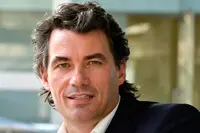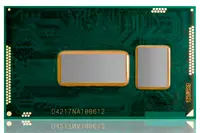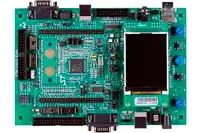Electronics News
Archive : 30 January 2015 год
 BT is planning to roll out 'G.fast' technology in a move that could see 500Mbit/s broadband being available to 'most of the UK' by 2025. Testing will start in two pilot locations this Summer.
BT is planning to roll out 'G.fast' technology in a move that could see 500Mbit/s broadband being available to 'most of the UK' by 2025. Testing will start in two pilot locations this Summer.
According to the company, G.fast will initially offer download rates of 'a few hundred Mbit/s'. Rates will then increase to around 500Mbit/s as further industry standards are secured and new kit is developed.
"BT is a world leader when it comes to fibre innovation and we are excited about the next stage in our story," said CEO Gavin Patterson, pictured. "We believe G.fast is the key to unlocking ultrafast speeds and we are prepared to upgrade large parts of our network should the pilots prove successful. That upgrade will depend however on there continuing to be a stable regulatory environment that supports investment."
The two pilots will start this Summer in Huntingdon and Gosforth, where some 4,000 homes and businesses will be involved. These pilots are said to build on recent tests at Adastral Park, BT's innovation centre. These test are believed to have shown that G.fast has the potential to deliver significant speed increases from existing and new fibre street cabinets as well as from other points closer to the customer. This is an important development as it means the technology can be deployed in a more efficient and rapid manner than previously thought.
Author
Graham Pitcher
Source: www.newelectronics.co.uk
 The Weightless SIG has completed its first quarter Weightless-N Working Group conference, convened to progress development of the new IoT specification for sub GHz spectrum.
The Weightless SIG has completed its first quarter Weightless-N Working Group conference, convened to progress development of the new IoT specification for sub GHz spectrum.
Professor William Webb, pictured, CEO of the Weightless SIG, commented: "Solid development work has progressed the specification significantly since October 2014. We are looking forward to publishing v1.0 of the standard in the second quarter".
According to the SIG, Weightless-N v1.0 will provide uplink connectivity using ultra narrowband technology, while future iterations of the standard will incorporate bidirectional communications. The standard will also support frequency hopping to provide interference tolerance, mobility support and security.
Work commenced on the development of the Weightless-N standard in the third quarter of 2014, after a comprehensive review of functional and parametric requirements for IoT connectivity technology in sub-GHz spectrum.
Weightless-N is set to offer the first global open Weightless standard for IoT connectivity over ISM bands. It will typically be deployed in unlicensed parts of the spectrum between 800 and 900MHz,including the 868MHz band in Europe and the 900MHz ISM band in the US.
Author
Graham Pitcher
Source: www.newelectronics.co.uk
 Intel has announced the availability of its 5th generation Intel Core vPro processor family which, it claims, will meet the needs of a more mobile and dynamic workforce
Intel has announced the availability of its 5th generation Intel Core vPro processor family which, it claims, will meet the needs of a more mobile and dynamic workforce
The latest iteration of Intel Core vPro processors offers wireless innovations, built in security, faster performance and improved manageability. It also believes the new processors will spawn PC design innovation, as well as widespread use of wireless displays and wireless docking, based on 60GHz communications.
"Our goal is to enable all users to simply work better by offsetting the growing challenges of today's businesses," said Tom Garrison, general manager of Intel's Business Client Platforms. "With new devices based on 5th generation Intel Core vPro processors, we aim to transform the user experience by helping them compute from virtually anywhere without the clutter and burden of wires."
The company also made claims about faster processing, enhanced battery life and the ability for OEMs to create thinner devices. Addressing the latter, Intel is expecting form factors up to three times thinner and 50% lighter than a four year old laptop.
Author
Graham Pitcher
Source: www.newelectronics.co.uk
 STMicroelectronics has extended its STM32F3 MCU family to address applications that require high performance and innovative features at affordable cost. The range now offers memory densities of up to 512kbyte of flash and 80kbyte of SRAM, as well as more capable peripherals for high speed control and off chip storage.
STMicroelectronics has extended its STM32F3 MCU family to address applications that require high performance and innovative features at affordable cost. The range now offers memory densities of up to 512kbyte of flash and 80kbyte of SRAM, as well as more capable peripherals for high speed control and off chip storage.
Added to the range are the STM32F303 and STM32F302, both featuring a 32bit ARM Cortex-M4 core running at 72MHz. New features are said to include extra SPI and I2C communication interfaces, and a Flexible Memory Controller (FMC) with 36MHz access on 8/16bit bus for various off chip storage and LCD modules. There are also up to three 144MHz 16bit motor control timers.
The new parts can be evaluated on two hardware boards: NUCLEO-F303RE, featuring a 64pin device for fast prototyping and sampling; and STM32303E-EVAL, pictured, featuring a 100pin device.
Author
Graham Pitcher
Source: www.newelectronics.co.uk
 Freescale is continuing its turn round from the seemingly dark days when it was dealing with the twin problems of large amounts of debt and declining product revenues.
Freescale is continuing its turn round from the seemingly dark days when it was dealing with the twin problems of large amounts of debt and declining product revenues.
Speaking exclusively with New Electronics, president and CEO Gregg Lowe – now about two and a half years into the job – pointed out two things. "Our top line revenue has outgrown the market again. We were ahead in 2013 over 2012 and now in 2014 over 2013. In fact, we outgrew the market by about a factor of two. And, for the second year in a row, all five of Freescale's business departments outgrew the market. Freescale has had two successful years and there are good signs for the future."
In the fourth quarter of 2014, Freescale recorded sales of $1.1billion and earnings of $274million. For the full year, sales were $4.63bn and earnings were $1.09bn.
Whilst debt has always been near the top of the agenda in discussions with Freescale, Lowe doesn't seem to be that bothered by the topic. "We have paid down another $1.2bn of debt over the last year and will be paying down $100m a quarter this year. There's still work to be done, but the debt isn't the millstone it was."
Asked how he explained the performance, Lowe noted: "A lot of hard work on the part of all the teams. There are many reasons why our performance has been as good as it has been, but one of the main ones is having differentiated products that excite customers and help them to develop better products. That has been key.
"Applications like the IoT need energy efficiency, scalable processors and connectivity – things which fit well with Freescale's skills."
Lowe said Freescale's product development teams have spent a lot of time looking at technology and product development, with the result that its five business groups are doing well.
But the general purpose microcontroller group was singled out by Lowe. "Geoff Lees (general manager of the group) has done a great job of delivering new products on advanced processes."
Freescale is moving some MCU products to a 28nm process, but Lowe said this isn't the radical move it appears. "The fact is that 28nm isn't a leading node today; there are a lot of products being made on that process. What we're doing is moving into these technologies as they become appropriate, but we're not pushing to the leading edge."
Automotive also gets special mention. "Whilst automotive has always been a strong market for Freescale, our performance in Japan has been good. We grew sales by 20% last year and revenues are now in excess of $100m. But we're still a small player in Japan because it's a hard nut to crack, but the signs are good."
Product development is a central requirement for any company and Lowe is keen to highlight work in progress. "We're developing new sensor technologies, for example. While it's still too early to discuss them in detail, we already have sample coming out of manufacturing. Amongst them are multiaxis sensors with low power consumption and small size. They'll be targeted at a lot of IoT applications which need sensing and connectivity. Although we won't be hitting the streets with the products quite yet, they will probably start appearing in Q2 this year."
A more unusual approach to product development is the company's Discovery Labs. "We're very excited about the concept," Lowe claimed. "It's a place for us to examine more radical, more innovative, more disruptive ideas. We opened the first one in Austin two years ago and added another in Toulouse last year. A lot of the projects in the labs won't go anywhere, but some will – and we have already seen one idea move from the lab into a product group, which is working on how to turn it into something we can sell."
Looking to the future, Lowe said it remains hard to call the market, but noted: "That has always been the case with the semiconductor market, because it isn't a 'straight line' business. But the trends look good and I'm encouraged about the prospects."
Author
Graham Pitcher
Source: www.newelectronics.co.uk
